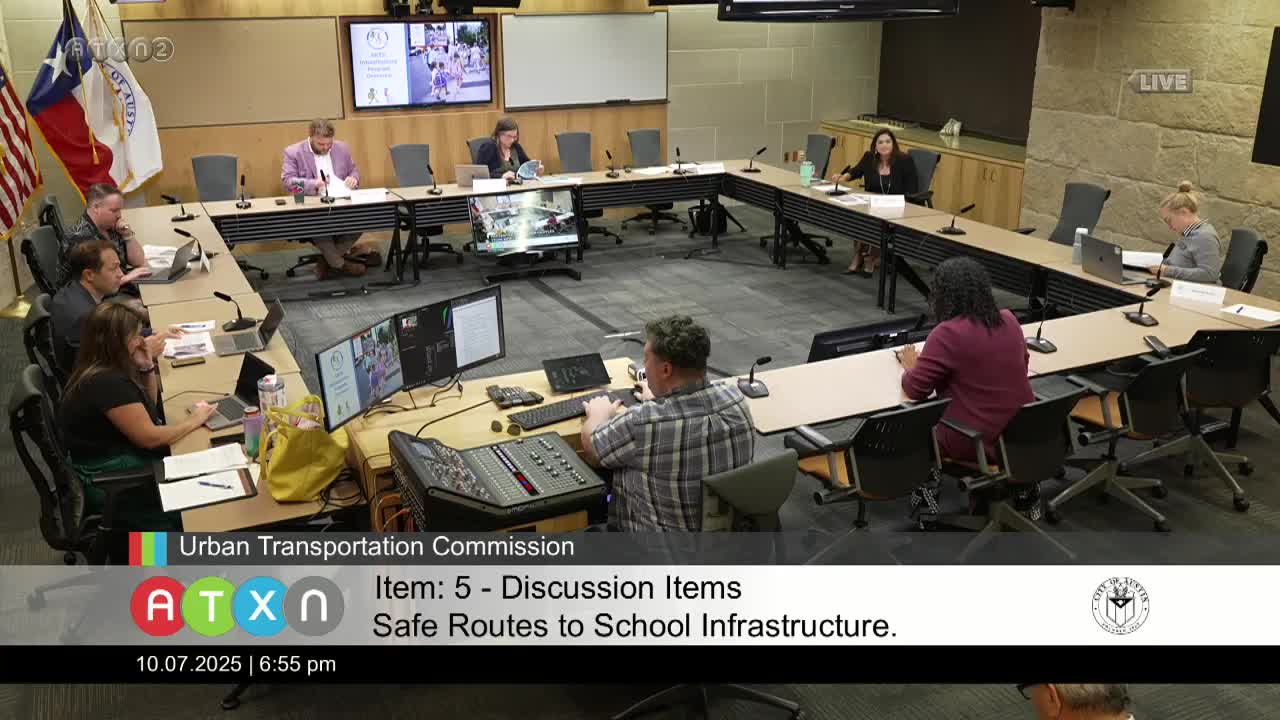Safe Routes to School reports $38.9M spent, 603 barriers fixed; plan refresh to account for school consolidations
October 07, 2025 | Austin, Travis County, Texas
This article was created by AI summarizing key points discussed. AI makes mistakes, so for full details and context, please refer to the video of the full meeting. Please report any errors so we can fix them. Report an error »

Austin Transportation & Public Works briefed the Urban Transportation Commission on progress from the city’s Safe Routes to School infrastructure program and plans to refresh its infrastructure plan to account for new schools and recent school boundary changes.
"The mission of the Safe Routes to School program is to increase the number of students walking and biking to school by creating a safer, healthier, and more equitable environment that fosters human powered transportation," said Colleen Gentles, the program’s infrastructure project manager.
Gentles summarized the Safe Routes program’s four arms — crossing-guard operations (more than 200 guards), in‑class education and trainings, engagement campaigns such as Park‑a‑Block‑and‑Walk and Bike on Wednesday, and capital infrastructure funded primarily by the 2016 and 2020 bond programs. She said the 2016 bond provided $27.5 million divided among council districts; the 2020 bond added $20 million with a charter‑school earmark of at least $1 million.
The program documented 4,600 barriers to walking and biking across 137 schools, then prioritized them by demand, crash/safety indicators, equity and stakeholder input. Gentles said 71% of identified barriers were sidewalks or curb ramps; the program prioritized projects with high benefit or favorable cost‑benefit profiles.
To date, Gentles reported that the program has spent about $38,900,000 on construction, has $2,600,000 encumbered, and $5,900,000 allocated but not yet assigned. The team has completed 603 barrier‑level improvements — about 65% intersection improvements and 27% sidewalk projects.
Gentles said the city will refresh the infrastructure plan under a Council‑initiated update (CIUR) to include high schools and any new public campuses built since the original audits; the refresh will also account for the recent AISD attendance‑boundary updates and consolidations. "We are planning on refreshing and updating our infrastructure plan, using internal staff and contract capacity," she said, noting planned walk audits for high schools and newly built campuses.
The presentation also highlighted a preliminary evaluation of school‑zone signs and beacons: TPW staff estimated that hundreds of new or modified school zones and an infrastructure maintenance investment of about $5 million could be needed to align signage and beacons with operations and locations of existing schools.
Members of the commission asked about partnerships with other jurisdictions such as municipal utility districts and school districts, and about how the program tracks mode share and safety outcomes. Gentles said the program uses in‑class reported mode data, crash statistics, and network analyses; she noted that longer‑term behavior change can take several years and that researchers at UT‑affiliated partners had shown effects requiring multi‑year follow‑up. The team will continue outreach and will update the plan and project list during the refresh.
"The mission of the Safe Routes to School program is to increase the number of students walking and biking to school by creating a safer, healthier, and more equitable environment that fosters human powered transportation," said Colleen Gentles, the program’s infrastructure project manager.
Gentles summarized the Safe Routes program’s four arms — crossing-guard operations (more than 200 guards), in‑class education and trainings, engagement campaigns such as Park‑a‑Block‑and‑Walk and Bike on Wednesday, and capital infrastructure funded primarily by the 2016 and 2020 bond programs. She said the 2016 bond provided $27.5 million divided among council districts; the 2020 bond added $20 million with a charter‑school earmark of at least $1 million.
The program documented 4,600 barriers to walking and biking across 137 schools, then prioritized them by demand, crash/safety indicators, equity and stakeholder input. Gentles said 71% of identified barriers were sidewalks or curb ramps; the program prioritized projects with high benefit or favorable cost‑benefit profiles.
To date, Gentles reported that the program has spent about $38,900,000 on construction, has $2,600,000 encumbered, and $5,900,000 allocated but not yet assigned. The team has completed 603 barrier‑level improvements — about 65% intersection improvements and 27% sidewalk projects.
Gentles said the city will refresh the infrastructure plan under a Council‑initiated update (CIUR) to include high schools and any new public campuses built since the original audits; the refresh will also account for the recent AISD attendance‑boundary updates and consolidations. "We are planning on refreshing and updating our infrastructure plan, using internal staff and contract capacity," she said, noting planned walk audits for high schools and newly built campuses.
The presentation also highlighted a preliminary evaluation of school‑zone signs and beacons: TPW staff estimated that hundreds of new or modified school zones and an infrastructure maintenance investment of about $5 million could be needed to align signage and beacons with operations and locations of existing schools.
Members of the commission asked about partnerships with other jurisdictions such as municipal utility districts and school districts, and about how the program tracks mode share and safety outcomes. Gentles said the program uses in‑class reported mode data, crash statistics, and network analyses; she noted that longer‑term behavior change can take several years and that researchers at UT‑affiliated partners had shown effects requiring multi‑year follow‑up. The team will continue outreach and will update the plan and project list during the refresh.
View full meeting
This article is based on a recent meeting—watch the full video and explore the complete transcript for deeper insights into the discussion.
View full meeting
